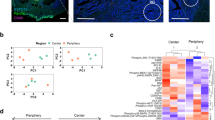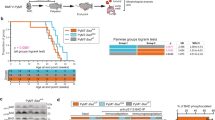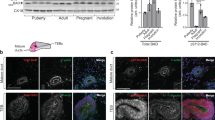Abstract
Emerging evidence suggests that the resistance of cancer stem cells (CSC) to many conventional therapies is one of the major limiting factors of cancer therapy efficacy. Identification of mechanisms responsible for survival and self-renewal of CSC will help design new therapeutic strategies that target and eliminate both differentiated cancer cells and CSC. Here we demonstrated the potential role of proapoptotic protein BAD in the biology of CSC in melanoma, prostate and breast cancers. We enriched CD44+/CD24− cells (CSC) by tumorosphere formation and purified this population by FACS. Both spheres and CSC exhibited increased potential for proliferation, migration, invasion, sphere formation, anchorage-independent growth, as well as upregulation of several stem cell-associated markers. We showed that the phosphorylation of BAD is essential for the survival of CSC. Conversely, ectopic expression of a phosphorylation-deficient mutant BAD induced apoptosis in CSC. This effect was enhanced by treatment with a BH3-mimetic, ABT-737. Both pharmacological agents that inhibit survival kinases and growth factors that are involved in drug resistance delivered their respective cytotoxic and protective effects by modulating the BAD phosphorylation in CSC. Furthermore, the frequency and self-renewal capacity of CSC was significantly reduced by knocking down the BAD expression. Consistent with our in vitro results, significant phosphorylation of BAD was found in CD44+ CSC of 83% breast tumor specimens. In addition, we also identified a positive correlation between BAD expression and disease stage in prostate cancer, suggesting a role of BAD in tumor advancement. Our studies unveil the role of BAD in the survival and self-renewal of CSC and propose BAD not only as an attractive target for cancer therapy but also as a marker of tumor progression.
Similar content being viewed by others
Log in or create a free account to read this content
Gain free access to this article, as well as selected content from this journal and more on nature.com
or
Abbreviations
- BAD:
-
BCL2-antagonist of cell death
- BrdU:
-
5-bromo-2′-deoxyuridine
- cdk:
-
cyclin-dependent kinase
- CSC:
-
cancer stem cell
- DC:
-
differentiated cancer
- FACS:
-
fluorescence-activated cell sorting
- E2:
-
17β-estradiol
- EGF:
-
epidermal growth factor
- MAPK:
-
mitogen-activated protein kinase
- PC:
-
parental cells
- PI:
-
propidium iodide
- shRNA:
-
small hairpin RNA
- TNFα:
-
tumor necrosis factor-alpha
References
Lapidot T, Sirard C, Vormoor J, Murdoch B, Hoang T, Caceres-Cortes J et al. A cells initiating human acute myeloid leukaemia after transplantation into SCID mice. Nature 1994; 367: 645–648.
Bonnet D, Dick JE . Human acute myeloid leukaemia is organized as a hierarchy that originates from a putative hematopoietic cell. Nat Med 1997; 3: 730–737.
Al-Hajj M, Wicha MS, Benito-Hernandez A, Morrison SJ, Clarke MF . Prospective identification of tumorigenic breast cancer cells. Proc Natl Acad Sci USA 2003; 100: 3983–3988.
Al-Hajj M, Becker MW, Wicha M, Weissman I, Clarke MF . Therapeutic implications of cancer stem cells. Curr Opin Genet Dev 2004; 14: 43–47.
Collins AT, Berry PA, Hyde C, Stower MJ, Maitland NJ . Prospective identification of tumorigenic prostate cancer stem cells. Cancer Res 2005; 65: 10946–10951.
Prince ME, Sivanandan R, Kaczorowski A, Wolf GT, Kaplan MJ, Dalerba P et al. Identification of a subpopulation of cells with cancer stem cell properties in head and neck squamous cell carcinoma. Proc Natl Acad Sci USA 2007; 104: 973–978.
Eramo A, Lotti F, Sette G, Pilozzi E, Biffoni M, Di Virgilio A et al. Identification and expansion of the tumorigenic lung cancer stem cell population. Cell Death Differ 2008; 15: 504–514.
Zhang S, Balch C, Chan MW, Lai HC, Matei D, Schilder JM et al. Identification and characterization of ovarian cancer-initiating cells from primary human tumors. Cancer Res 2008; 68: 4311–4320.
Schatton T, Murphy GF, Frank NY, Yamaura K, Waaga-Gasser AM, Gasser M et al. Identification of cells initiating human melanomas. Nature 2008; 451: 345–349.
Polyak K, Hahn WC . Roots and stems: stem cells in cancer. Nat Med 2006; 2: 296–300.
Dean M, Foio T, Bates S . Tumour stem cells and drug resistance. Nat Rev Cancer 2005; 5: 275–284.
Frank NY, Schatton T, Frank MH . The therapeutic promise of the cancer stem cell concept. J Clin Invest 2010; 120: 41–50.
Konopleva M, Zhao S, Hu W, Jiang S, Snell V, Weidner D et al. The anti-apoptotic genes Bcl-X(L) and Bcl-2 are over-expressed and contribute to chemoresistance of non-proliferating leukaemic CD34+ cells. Br J Haematol 2002; 118: 521–534.
Madjd Z, Mehrjerdi AZ, Sharifi AM, Molanaei S, Shahzadi SZ, Asadi-Lari M . CD44+ cancer cells express higher levels of the anti-apoptotic protein Bcl-2 in breast tumours. Cancer Immun 2009; 9: 4.
Datta SR, Dudek H, Tao X, Masters S, Fu H, Gotoh Y et al. Akt phosphorylation of BAD couples survival signals to the cell-intrinsic death machinery. Cell 1997; 91: 231–241.
Harada H, Becknell B, Wilm M, Mann M, Huang LJ, Taylor SS et al. Phosphorylation and inactivation of BAD by mitochondria-anchored protein kinase A. Mol Cell 1999; 3: 413–422.
Shimamura A, Ballif BA, Richards SA, Blenis J . Rsk1 mediates a MEK-MAP kinase cell survival signal. Curr Biol 2000; 10: 127–135.
Schürmann A, Mooney AF, Sanders LC, Sells MA, Wang HG, Reed JC et al. p21-activated kinase 1 phosphorylates the death agonist bad and protects cells from apoptosis. Mol Cell Biol 2000; 20: 453–461.
Sastry KS, Smith AJ, Karpova Y, Datta SR, Kulik G . Diverse anti-apoptotic signaling pathways activated by Vasoactive Intestinal Peptide, Epidermal Growth Factor and PI3 Kinase in prostate cancer cells converge on BAD. J Biol Chem 2006; 281: 20891–20901.
Sastry KS, Karpova Y, George K . Epidermal growth factor protects prostate cancer cells from apoptosis by inducing BAD phosphorylation via redundant signaling pathways. J Biol Chem 2006; 281: 27367–27377.
Sastry KS, Karpova Y, Prokopovich S, Smith AJ, Essau B, Gersappe A et al. Epinephrine protects cancer cells from apoptosis via activation of Protein Kinase A and BAD phosphorylation. J Biol Chem 2007; 282: 14094–14100.
Smith AJ, Karpova Y, D'Agostino R Jr, Willingham M, Kulik G . Expression of the Bcl-2 protein BAD promotes prostate cancer growth. PLoS One 2009; 4: e6224.
Cannings E, Kirkegaard T, Tovey SM, Dunne B, Cooke TG, Bartlett JM . Bad expression predicts outcome in patients treated with tamoxifen. Breast Cancer Res Treat 2007; 102: 173–179.
Craik AC, Veldhoen RA, Czernick M, Buckland TW, Kyselytzia K, Ghosh S et al. The BH3-only protein Bad confers breast cancer taxane sensitivity through a nonapoptotic mechanism. Oncogene 2010; 29: 5381–5391.
Marchion DC, Cottrill HM, Xiong Y, Chen N, Bicaku E, Fulp WJ et al. BAD phosphorylation determines ovarian cancer chemosensitivity and patient survival. Clin Cancer Res 2011; 17: 6356–6366.
Sheridan C, Brumatti G, Martin SJ . Oncogenic B-RafV600E inhibits apoptosis and promotes ERK-dependent inactivation of Bad and Bim. J Biol Chem 2008; 238: 22128–22135.
La Porta CA, Zapperi S . Human breast and melanoma cancer stem cells biomarkers. Cancer Lett 2013; 338: 69–73.
Zapperi S, La Porta CA . Do cancer cells undergo phenotypic switching? The case for imperfect cancer stem cell markers. Sci Rep 2012; 2: 441.
Ponti D, Costa A, Zaffaroni N, Pratesi G, Petrangolini G, Coradini D et al. Isolation and in vitro propagation of tumorigenic breast cancer cells with stem/progenitor cell properties. Cancer Res 2005; 65: 5506–5511.
Yan W, Chen Y, Yao Y, Zhang H, Wang T . Increased invasion and tumorigenicity capacity of CD44+/CD24- breast cancer MCF7 cells in vitro and in nude mice. Cancer Cell Int 2013; 13: 62.
Fillmore C, Kuperwasser C . Human breast cancer cell lines contain stem-like cells that self-renew, give rise to phenotypically diverse progeny and survive chemotherapy. Breast Cancer Res 2008; 10: R25.
Yin H, Glass J . The phenotypic radiation resistance of CD44+/CD24−or low breast cancer cells is mediated through the enhanced activation of ATM signaling. PLoS One 2011; 6: e24080.
Hurt EM, Kawasaki BT, Klarmann GJ, Thomas SB, Farrar WL . CD44+ CD24(−) prostate cells are early cancer progenitor/stem cells that provide a model for patients with poor prognosis. Br J Cancer 2008; 98: 756–765.
Tan Y, Demeter MR, Ruan H, Comb MJ . BAD ser-155 phosphorylation regulates BAD/Bcl XL interaction and cell survival. J Biol Chem 2000; 18: 25865–25869.
Oltersdorf T, Elmore SW, Shoemaker AR, Armstrong RC, Augeri DJ, Belli BA et al. An inhibitor of Bcl-2 family proteins induces regression of solid tumours. Nature 2005; 435: 677–681.
Majumdar PK, Sellers WR . Akt-regulated pathways in prostate cancer. Oncogene 2005; 14: 7465–7474.
Faivre S, Djelloul S, Raymond E . New paradigms in anticancer therapy: targeting multiple signaling pathways with kinase inhibitors. Semin Oncol 2006; 33: 407–420.
Gollob JA, Wilhelm S, Carter C, Kelley SL . Role of Raf kinase in cancer: therapeutic potential of targeting the Raf/MEK/ERK signal transduction pathway. Semin Oncol 2006; 33: 392–406.
Mimeault M, Batra SK . New promising drug targets in cancer- and metastasis-initiating cells. Drug Discov Today 2010; 15: 354–364.
Clark GM, McGuire WL . Steroid receptors and other prognostic factors in primary breast cancer. Semin Oncol 1988; 15: 20–25.
Allred DC, Brown P, Medina D . The origins of estrogen receptor α-positive and estrogen receptor α-negative human breast cancer. Breast Cancer Res 2004; 6: 240–245.
Mimeault M, Johansson SL, Batra SK . Pathobiological implications of the expression of EGFR, pAkt, NF-κB and MIC-1 in prostate cancer stem cells and their progenies. PLoS One 2012; 7: 31919.
Mazzoleni S, Politi LS, Pala M, Cominelli M, Franzin A, Sergi Sergi L et al. Epidermal growth factor receptor expression identifies functionally and molecularly distinct tumor-initiating cells in human glioblastoma multiforme and is required for gliomagenesis. Cancer Res 2010; 70: 7500–7513.
Diaz A, Leon K . Therapeutic approaches to target cancer stem cells. Cancers 2011; 3: 3331–3352.
Zinkel S, Gross A, Yang E . BCL2 family in DNA damage and cell cycle control. Cell Death Differ 2006; 13: 1351–1359.
Jablonska B, Aguirre A, Vandenbosch R, Belachew S, Berthet C, Kaldis P et al. Cdk2 is critical for proliferation and self-renewal of neural progenitor cells in the adult subventricular zone. J Cell Biol 2007; 179: 1231–1245.
Gupta PB, Onder TT, Jiang G, Tao K, Kuperwasser C, Weinberg RA et al. Identification of selective inhibitors of cancer stem cells by high-throughput screening. Cell 2009; 138: 645–659.
Mimeault M, Hauke R, Batra SK . Recent advances on the molecular mechanisms involved in the drug resistance of cancer cells and novel targeting therapies. Clin Pharmacol Ther 2008; 83: 673–691.
Li X, Lewis MT, Huang J, Gutierrez C, Osborne CK, Wu MF et al. Intrinsic resistance of tumorigenic breast cancer cells to chemotherapy. J Natl Cancer Inst 2008; 100: 672–679.
Bao S, Wu Q, McLendon RE, Hao Y, Shi Q, Hjelmeland AB et al. Glioma stem cells promote radioresistance by preferential activation of the DNA damage response. Nature 2006; 444: 756–760.
Chaffer CL, Brueckmann I, Scheel C, Kaestli A, Wiggins PA, Rodrigues LO et al. Normal and neoplastic nonstem cells can spontaneously convert to a stem-like state. Proc Natl Acad Sci USA 2011; 108: 7950–7955.
Al-Bazz YO, Underwood JC, Brown BL, Dobson PR . Prognostic significance of Akt, phospho-Akt and BAD expression in primary breast cancer. Eur J Cancer 2009; 45: 694–704.
Korkaya H, Wicha MS . HER2 and breast cancer stem cells: More than meets the eye. Cancer Res 2013; 73: 3489–3493.
Singh S, Bora-Singhal N, Kroeger J, Laklai H, Chellappan SP . βArrestin-1 and Mcl-1 modulate self-renewal growth of cancer stem-like side-population cells in non-small cell lung cancer. PLoS One 2013; 8: 55982.
Shan J, DSouza SP, Bakhru S, Al-Azwani EK, Ascierto ML, Sastry KS et al. TNRC9 downregulates BRCA1 expression and promotes breast cancer aggressiveness. Cancer Res 2013; 73: 2840–2849.
Acknowledgements
The authors thank Sara Tomei and Jingxuan Shan for help in statistical analyses and Aleksandra Liberska for FACS. This work was supported by the BMRP Funding of Weill Cornell Medical College in Qatar and Qatar Biomedical Research Institute.
Author information
Authors and Affiliations
Corresponding authors
Ethics declarations
Competing interests
The authors declare no conflict of interest.
Additional information
Edited by R De Maria
Supplementary Information accompanies this paper on Cell Death and Differentiation website
Supplementary information
Rights and permissions
About this article
Cite this article
Sastry, K., Al-Muftah, M., Li, P. et al. Targeting proapoptotic protein BAD inhibits survival and self-renewal of cancer stem cells. Cell Death Differ 21, 1936–1949 (2014). https://doi.org/10.1038/cdd.2014.140
Received:
Revised:
Accepted:
Published:
Issue date:
DOI: https://doi.org/10.1038/cdd.2014.140
This article is cited by
-
MicroRNA miR-20a-5p targets CYCS to inhibit apoptosis in hepatocellular carcinoma
Cell Death & Disease (2024)
-
AMPK inhibition sensitizes acute leukemia cells to BH3 mimetic-induced cell death
Cell Death & Differentiation (2024)
-
Differential responsiveness to BRAF inhibitors of melanoma cell lines BRAF V600E-mutated
Journal of Translational Medicine (2020)
-
Dual-targeted therapeutic strategy combining CSC–DC-based vaccine and cisplatin overcomes chemo-resistance in experimental mice model
Clinical and Translational Oncology (2020)
-
Identification of Key Potential Targets and Pathway for Arsenic Trioxide by Systemic Bioinformatics Analysis in Pancreatic Cancer
Pathology & Oncology Research (2019)



